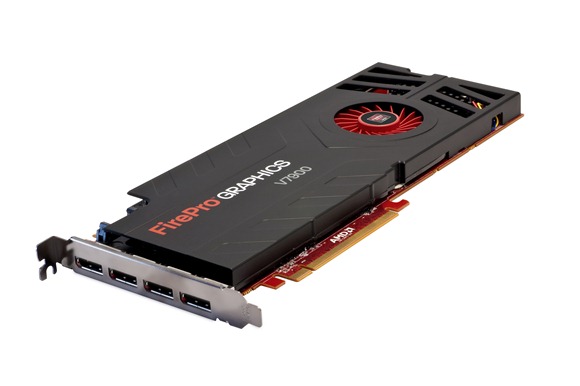 Just over 90 days ago, I received an AMD FirePro v7900 card here at The Orbiting O’Odua.
Just over 90 days ago, I received an AMD FirePro v7900 card here at The Orbiting O’Odua.
Then I got to work.
I have the privilege of using HP z600 Personal Workstations at each of the offices I work out of: at the Orbiting O’Odua, at MedikLabs, and at Logikworx.
I know, the delectable HP z800 John Obeto Specials have been sent back. Believe me, tears flowed!
However, there the commonality stops.

I decided to review the FirePro v7900 against the FX 4800.
The AMD FirePro v7900
For a long time now, it seemed AMD was content to just wreck havoc on the consumer side of video processing, leaving the workstation space to Nvidia, with its line of Quadro cards. No longer, it seems.
When I heard of the FirePro, the bleeding-edge part of me wanted one immediately.
I reached out to AMD, and they replied by not only agreeing to send me a card for review, but also allowing me to be briefed by Simon V. from the AMD Pro Graphics Team.
Turns out that the FirePro wasn’t just a rehash of the RADEON cards.
The FirePro was created to address the following points shown in the graphic below.

- AMD Eyefinity technology
- Geometry boost,
- AMD PowerTune technology
- GDDR5 memory, and
- DisplayPort 1.2 support.

I told him of the fact that I was going to run it against an FX4800 at the high end, and he said, “go ahead”, with nary a word of concern. At that time, I was truly determined to try it against the FX4800 as opposed to the lesser cards I have just to see if his confidence in his product was misplaced.
Installation
I opened up the z600, snapped a couple of latches, and the innards of the workstation laid bare.
For those of you who haven’t seen the insides of any member of the z-series of workstations from HP, you’re missing a lot. These devices are marvels of engineering, and design. Form follows function symbiotically, and making changes to the hardware is a breeze.
I removed the FX 4800, installed the FirePro v7900, and closed up the box. I changed the video output cables from dual-link DVI cables to DisplayPort ones.
And that was it.
I fired up the workstation, and immediately, Windows 7 recognized the product, and I was asked, through Windows Update, if I wanted to download the correct drivers for the card. I agreed, and downloading commenced.
After the download was complete, an annoyingly long time due to the slooow broadband service here, the drive upgrade was initialized, and installed. I then rebooted the system.
Using the FirePro v7900
I fired up Windows 7 Ultimate Edition. Windows detected the card, ask for permission to download and install the drivers for the FirePro, commenced the tasks, and voila, install success a few minutes later. I rebooted to make the system happy, came back on, and the computer was singing in dual 2560x1600 happiness.
The AMD FirePro v7900 is one sweet card.
My first series of runs with it was to test my perceived speediness of the card.
It was fast and extremely responsive. In fact, some of the issues I had with the Nvidia Quadro FX4800, such as stuttering – where the system takes a few seconds to determine if a mouse click was actually that – vanished completely. Also vanished was the sudden fading to total blackness of my Windows Live mail screen, an issue specific to Windows Live mail only, and only on this system.
I had thought the differences between the cards would either be slight or imperceptible to the point of being negligible. However, the perceived speediness was there, and it made me to get my internal test suite out.
I performed the following tasks with the Z600 workstation, first using the Nvidia Quadro FX4800, and then I repeated them while using the FirePro v7900:
- A little decision analysis using a stochastic modeling uncertainty quickie
- Performing flow analysis using a part I designed,
- Animating a building I had drawn in TrueSpace
In all, the FirePro performed flawlessly, and didn’t need my tweaking to perform perceptibly better.
Conclusions
AMD has entered the high-end, professional graphics space with a bang.
I do believe the bang is loud enough to wake up the current players here, and frighten them into either competing, or to give up the ghost.
AMD seems to have taken up the challenge.
Consumers are going to win here, as we would now have a very formidable competitor to Nvidia here and now.
I was going to title this review, “How do you speed up an HP z600 Personal Workstation”, but the snide, unmerciful comments I got when I teased about the article name, has made me reconsider that article name.
Finally, I am impressed enough with the FirePro that I cannot wait to try out the flagship FirePro v9800 when that product is released. In fact, upon receipt of the word that the v9800 is on its way to me, I will go ahead and order the FX6000 to test it against.
In the meantime, I believe that I will be putting up the FX4800 as a prize here at AbsolutelyWindows, during an impromptu contest.
UPDATE: I converted the z600 to Windows 8 Developer Preview this weekend.
How did the FirePro perform?
Wicked fast.
In fact, tabbing thorough open apps happened so quickly that I continued to do so for another cycle! Yes, it was that fast.



